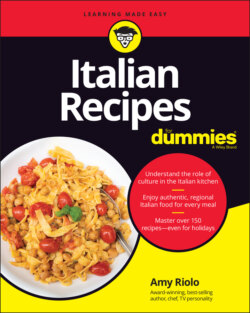Читать книгу Italian Recipes For Dummies - Amy Riolo - Страница 32
How Romans and Greeks laid the foundation for Italian cuisine
ОглавлениеThe Greeks considered Southern Italy, from Naples south, to be the promised land. From the eighth to the fifth centuries B.C.E., they began populating the entire region, beginning with the Italian island of Ischia. For this reason, there are more Greek monuments in Sicily today than there are in modern Greece, and the regions of Southern Italy became known as Magna Graecia, or “Greater Greece.” The fertile land, access to additional trade routes, and beautiful terrain inspired the Greeks to set up polis, or city states, in Coastal Greek towns.
Napoli was one of the main cultural centers as were modern-day Reggio Calabria and Crotone, along with many others. The Greeks set up monuments to their gods. Even the Greek philosopher and Mathematician Pythagoras set up his school of mathematics, nutrition, philosophy, and music in Kroton, now called Crotone, Italy. An old adage says “When the Romans were still poor shepherds, Pythagoras was teaching in Crotone.” These Greek influences did leave a footprint on the cuisine of the Italian south. Pythagoras, for example, was a strict vegetarian and asked his disciples to give up meat in order to study with him. Greek herbs and spices such as oregano, anise, and eucalyptus became widely used. Manners of preparing meat and wine varieties, such as Greco and Aglianico, for example, came directly from Greece.
When the Romans came into power, they did not want to turn their backs on Greek cultural traditions, which they greatly respected, but rather build upon them. Many Romans went to Naples to experience the Greek way of life. The Roman philosopher Virgil was known for saying that Naples was, in fact, a city where one could live and die in the manner of the Greeks. Even Roman emperors and public figures recited plays in Greek when performing and presenting at amphitheaters in Naples, since it was a Greek speaking city at the time.
Romans improved upon Etruscan and Greek wine-making and culinary techniques and began introducing both olive trees and vines to Gaul (modern-day France) and other areas in the empire. The Romans set up a network of trade that spanned from the modern-day United Kingdom, through Western Europe, into North Africa, the Middle East, Central Asia, and China. Sometimes, they used existing trade routes such as the Silk Road, the Incense trails, and those set up by the Vikings; other times, they constructed their own routes.
Regardless of which routes they used, Roman commerce set up a sophisticated structure of international commerce that we now refer to as globalization. Roman Emperors sent fleets out to various areas of the globe to procure the best ingredients. They knew, for example, when the best prawns were available in the Mediterranean and sent ships to fish for them off the coast of Libya. They procured enough wheat from North Africa to fund the entire empire. Elaborate murals and depictions from Pompei provide a glimpse into the daily lives of ancient Romans, the ingredients they had at their disposal and how they cooked and shopped.
Spiced wine, or mead, along with barley and wheat bread, grains and pulses, fresh fruit (figs, pomegranate, apples, grapes, quinces, and dates) and vegetables (cucumbers, lettuce, leeks, greens, broccoli, onions, and garlic) along with legumes such as chickpeas and fava were prepared in addition to poultry, foul, and meat by the ancient Romans. Food was heavily spiced because spices were a symbol of wealth and luxury as well as traditional medicinals. Roman cuisine is most often depicted using garum (a fermented fish sauce) as a condiment. The Romans taxed citizens heavily on salt and wheat, so they invented ingenious ways of flavoring food (such as with preserved fish) and mimicking a staple grain (such as burning the grain that came out of winnowers and grinding it again by hand, known as grano arso, or “burnt grain” in Italian).
Black pepper, imported from Asia, was coveted by the Romans both as a commodity and a seasoning. They imported so much of it into the Egyptian port city of Alexandria that in antiquity one of the city’s entry points was known as “The Pepper Gate.” One of the greatest resources available on Roman cuisine is called On Cooking or De Re Coquinaria in Latin. The first-century book was written by the Roman philosopher Apicius, who is said to be the father of all gourmands. Legend has it that when Apicius learned that he could no longer afford the delicacies his palate craved, he committed suicide. His book recounts recipes from not only Rome itself, but other parts of the empire as well, and it’s still available for purchase today. Many international cooking schools, restaurants, and culinary centers are named after Apicius, and for years it was believed that he wrote the first Western cookbook ever found. In the middle of the fourth century B.C.E., however, the Greek gourmand Archestratus wrote “Fragments from the Life of Luxury” in Sicily.
